Hummingbird behaviors that you may not know include their ability to remember specific feeding locations, forming intricate aerial courtship displays, and possessing a remarkable memory that allows them to recall thousands of flowers within their territories.
In the enchanting realm of avian wonders, few creatures captivate the imagination quite like hummingbirds. While their dazzling plumage and lightning-fast aerial acrobatics have long been celebrated, there exists a hidden tapestry of hummingbird behaviors that remains largely unnoticed by the casual observer.
These diminutive dynamos are not just the jewels of the sky; they are masters of peculiar and fascinating habits that add an extra layer of intrigue to their already beguiling existence. From mysterious mid-air rituals to ingenious feeding strategies, the hummingbird’s world is a treasure trove of secrets waiting to be unveiled. Join us as we delve into the extraordinary, the unexpected, and the utterly mesmerizing hummingbird behaviors that defy expectations and unveil a new dimension to these pint-sized marvels of the avian realm.

Hummingbird Behaviors That You May Not Know
Unveiling the Enigmatic World of Hummingbirds
Hummingbirds, those vibrant avian gems, are known for their dazzling plumage and remarkable agility. Beyond their visual splendor, these tiny creatures exhibit a myriad of fascinating behaviors that often escape our notice. Delve into the lesser-known aspects of hummingbird life, uncovering the mysteries that make them truly unique.
Understanding Unseen Marvels: A Glimpse into Hummingbird Behaviors
In the world of hummingbirds, it’s not just about the mesmerizing dance of colors and lightning-fast flight. These tiny wonders are also skilled acrobats, capable of hovering in mid-air and even flying backward. Witnessing their aerial displays, one can’t help but marvel at the precision and agility that define these avian wonders. It’s not just about their dainty appearance; it’s about the extraordinary behaviors that set them apart.
The Intricacies of Hummingbird Feeding: A Symphony of Sips
When it comes to feeding, hummingbirds are not just visitors to flowers; they are pollination maestros. Their slender bills and specialized tongues enable them to extract nectar with surgical precision, showcasing an intricate dance between bird and bloom. The symbiotic relationship between hummingbirds and flowers goes beyond a simple sip; it’s a delicate choreography that sustains both flora and fauna.
Secrets of Hummingbird Communication: Beyond the Buzzing
Hummingbirds communicate not through melodic calls, but through a language of clicks and whirs that are imperceptible to the human ear. These subtle sounds play a crucial role in establishing dominance, courtship, and even expressing territorial boundaries. The auditory world of hummingbirds is a nuanced symphony, a hidden dimension that adds depth to their already enchanting presence.
Intriguing Mating Rituals: Courtship in the Air
The courtship rituals of hummingbirds are a spectacle to behold. The males, adorned with vibrant plumage, engage in high-speed aerial displays to woo their potential mates. It’s a breathtaking dance in the sky, a display of agility and vibrancy that goes beyond mere instinct. Understanding these intricate mating rituals unveils a layer of complexity in hummingbird behavior that adds to the allure of these tiny marvels.
Physical Characteristics
Overview of Hummingbird Anatomy
Hummingbirds, renowned for their mesmerizing flight and vibrant plumage, boast a remarkable anatomy that sets them apart in the avian world. With diminutive bodies typically ranging from 3 to 5 inches, these agile creatures are adorned with iridescent feathers that shimmer like precious gemstones. Their lightweight skeletons and powerful muscles enable unparalleled maneuverability, allowing them to hover effortlessly in mid-air, captivating observers worldwide.
Unique Features Contributing to Distinctive Behaviors
Rapid Wing Beats
At the heart of the hummingbird’s enchanting aerial ballet lies its astonishing rapid wing beats, averaging an astounding 50 to 80 flaps per second. This extraordinary capability not only sustains their mid-air suspension but also contributes to their signature humming sound, earning them their whimsical name. Witnessing their wings blur in motion is an awe-inspiring spectacle, often described as a living jewel buzzing through the air.
Specialized Bill Structure
The hummingbird’s bill, an engineering marvel, is perfectly adapted for their exclusive nectar-based diet. Long and slender, resembling a delicate needle, it seamlessly fits into the intricate folds of tubular flowers. The tiny, tube-like tongue at the bill’s tip acts as a precision tool, extracting nectar with unparalleled efficiency. Their bill, often likened to a natural sipping straw, exemplifies nature’s ingenuity at its finest.
Exceptional Vision
Hummingbirds boast exceptional vision, a crucial aspect of their foraging and territorial behaviors. With the ability to perceive a vast spectrum of colors, including ultraviolet, these avian acrobats navigate their surroundings with remarkable precision. Their keen eyesight is often compared to a kaleidoscope, allowing them to spot minuscule insects, rivals, and potential mates amidst a sea of blossoms. This visual prowess plays a pivotal role in their survival and adds an extra layer of wonder to their already captivating existence.
Feeding Behaviors
Hovering
Mechanism of Hovering
Hummingbirds, the virtuosos of flight, achieve their captivating hover through an intricate interplay of physiology and biomechanics. Unlike most birds, their shoulder joints allow a full 360-degree rotation, enabling a figure-eight pattern with their wings. This figure-eight motion generates lift on both the upstroke and downstroke, creating a sustained hover. It’s a balletic fusion of muscle power and aerodynamic finesse, often likened to a miniature helicopter in action.
Energetic Costs and Advantages
The mesmerizing hovering of hummingbirds comes at an energetic price. To maintain this stationary flight, they exhibit an unparalleled metabolism, often consuming nectar equivalent to half their body weight daily. This voracious energy intake is vital for their high-paced lifestyle, providing the fuel needed for constant wing beats and the demands of an ever-active metabolism. It’s a delicate balance of energy expenditure and replenishment that defines their survival strategy.
Feeding Territories
Defense Mechanisms
Hummingbirds, despite their diminutive size, are fiercely territorial when it comes to feeding grounds. To safeguard their precious nectar sources, these agile guardians employ a variety of defensive tactics. Intruders are met with aerial displays of acrobatics, rapid dives, and aggressive chirps. Their territorial defense is a spectacle often described as a tiny, feathery guardian fiercely protecting its floral kingdom.
Intraspecific Competition
Within the realm of hummingbirds, competition for limited nectar resources is intense. Intraspecific battles unfold as these avian marvels engage in mid-air skirmishes, showcasing their agility and determination. The competition is not only about securing sustenance but also establishing dominance and securing mating privileges. This dynamic interplay of competition within their own ranks adds another layer of intrigue to the vibrant world of hummingbird feeding behaviors.
In essence, the feeding behaviors of hummingbirds, characterized by hovering mastery, territorial defense mechanisms, and intraspecific competition, underscore the resilience and adaptability of these enchanting creatures in their quest for sustenance and survival.
Social Interactions
Aggressive Behaviors
Territorial Disputes
Hummingbirds, despite their delicate appearance, engage in fierce territorial disputes to safeguard their coveted feeding and nesting spaces. These battles often involve dazzling aerial acrobatics and rapid chases, creating a spectacle reminiscent of a high-stakes dance in the sky. The intensity of these territorial disputes highlights the importance of securing prime locations for access to abundant nectar sources.
Aggressive Feeding
In the competitive world of hummingbirds, aggression extends beyond territorial boundaries to feeding interactions. These feisty aviators fiercely guard their chosen flowers, often engaging in aggressive feeding behaviors to assert dominance. Rapid dives, mid-air collisions, and assertive displays of dominance become the norm as they vie for exclusive access to the most bountiful nectar-laden blooms.
Courtship Rituals
Elaborate Aerial Displays
Hummingbirds, renowned for their breathtaking displays of agility, translate their aerial prowess into elaborate courtship rituals. Males embark on captivating airborne performances, executing intricate maneuvers to showcase their strength and agility. These displays, resembling a choreographed ballet in mid-air, serve as both a visual spectacle and a means of communicating fitness and suitability as a potential mate.
Vocalizations and Communication
Beyond the visual splendor of courtship displays, hummingbirds employ vocalizations to communicate during the intricate dance of courtship. High-pitched chirps, trills, and distinctive calls echo through their habitats as potential mates engage in vocal exchanges. These sonic expressions, coupled with synchronized aerial displays, form a nuanced language that transcends the visual realm, allowing hummingbirds to convey their intentions and strengthen social bonds.
Migration Patterns
Overview of Hummingbird Migration
The hummingbird’s migration is a testament to nature’s precision and resilience, encompassing an awe-inspiring journey that spans thousands of miles. These diminutive travelers embark on remarkable migrations, defying their size and fragility. From the northern reaches of their breeding grounds to the warmth of winter havens, hummingbirds traverse continents in a dazzling display of avian tenacity.
Factors Influencing Migration Behaviors
Environmental Cues
Hummingbirds are astute navigators, relying on environmental cues to guide their migratory routes. Changes in daylight duration, temperature, and even the availability of blooming flowers act as navigational signposts. These avian marvels synchronize their departure with the shifting seasons, ensuring they follow a migratory path aligned with the abundance of nectar and the favorable conditions essential for their survival.
Physiological Changes
As migration beckons, hummingbirds undergo remarkable physiological changes to meet the demands of their arduous journey. A surge in hormones triggers hyperphagia, a period of intensified feeding, allowing them to amass the energy reserves necessary for sustained flight. During this phase, they may double their body weight, a crucial adaptation that enables them to traverse vast distances without compromising their delicate frames. This physiological metamorphosis is a testament to the intricacies of their survival strategy.
In essence, the migration patterns of hummingbirds weave a narrative of instinctual navigation and remarkable adaptation. Guided by environmental cues and fueled by physiological transformations, these avian globetrotters defy their diminutive stature to embark on epic journeys, showcasing the indomitable spirit of nature’s winged wonders.
Sleeping Habits
Nocturnal Torpor
Energy Conservation During the Night
In a captivating twist to their diurnal vibrancy, hummingbirds exhibit a unique adaptation known as nocturnal torpor during their nightly rest. To conserve energy, these avian marvels undergo a state of metabolic slowdown, akin to a temporary hibernation. As the sun sets and nectar becomes scarce, hummingbirds enter a sleep mode characterized by a significant drop in heart rate, body temperature, and metabolic activity. This nightly reprieve allows them to survive the energy-demanding lifestyle of the day.
Physiological Adaptations for Torpor
Hummingbirds have evolved remarkable physiological adaptations to navigate the challenges of nocturnal torpor. During this state, their metabolic rate may plummet to as low as 1/15th of their normal rate. This drastic reduction in energy expenditure allows them to endure the night without the need for frequent feeding. Additionally, their ability to quickly reawaken from this torpid state positions them to rapidly respond to the demands of the following day, ensuring they are ready for the dynamic and energy-intensive activities that daylight brings.
Cognitive Abilities
Spatial Memory
Navigation and Foraging Strategies
Hummingbirds, despite their diminutive size, boast exceptional spatial memory that plays a pivotal role in their navigation and foraging strategies. These avian navigators remember the locations of numerous blooming flowers within their expansive territories, creating mental maps that guide their intricate flight patterns. This spatial prowess enables them to efficiently navigate complex environments, ensuring optimal foraging routes that maximize access to nectar-rich blooms.
Memory in Relation to Feeding Sites
The cognitive abilities of hummingbirds extend to the realm of feeding as well. Their remarkable memory allows them to recall specific feeding sites, remembering not only the location but also the timing of flower blooming cycles. This sophisticated memory system enables them to revisit and exploit these floral resources at precisely the right moments, showcasing an intricate interplay between cognitive function and survival strategies.
Problem-Solving Skills
Tool Use Observations
In a surprising revelation of cognitive prowess, there have been intriguing observations of hummingbirds exhibiting rudimentary tool use. While not as elaborate as in some other avian species, there are instances of these agile birds using twigs or other objects to extract insects from crevices. This adaptive behavior suggests a level of problem-solving and tool manipulation previously underestimated in these small yet highly intelligent creatures.
Learning from Environmental Challenges
Hummingbirds showcase an impressive capacity for learning from environmental challenges. Whether overcoming obstacles in flight or adapting to changes in their habitat, these avian intellects exhibit a flexible problem-solving mindset. They learn from experiences, refining their strategies for foraging, navigating, and interacting with their surroundings, underscoring the dynamic and adaptive nature of their cognitive abilities.
Breeding Behaviors
Nesting Habits
Selection of Nesting Sites
Hummingbirds, despite their vibrant and energetic lifestyles, exhibit meticulous care in selecting nesting sites. These avian architects choose locations that provide shelter, camouflage, and proximity to nectar sources. From the shelter of tree branches to the hidden cradles of leaves, the meticulous process of selecting a nesting site ensures the safety and survival of the upcoming generation.
Nest Construction and Maintenance
Nest construction is a testament to the precision and artistry of hummingbirds. Using materials like spider silk, moss, and plant down, females create intricate cup-shaped nests. The exterior is often camouflaged with lichen or bark, blending seamlessly with the surrounding environment. This architectural marvel is not a one-time effort; females meticulously maintain and repair nests throughout the breeding season, ensuring a secure haven for their precious offspring.
Parental Care
Incubation and Fledging Periods
Parental care among hummingbirds extends from the construction of nests to the critical stages of incubation and fledging. Females incubate the eggs for about two weeks, keeping a watchful eye over the delicate process. Once hatched, the fledging period, where the chicks grow feathers and learn to fly, unfolds in a span of three weeks. This period demands constant vigilance and nourishment from both parents to ensure the survival of the fledglings.
Role of Male and Female in Parenting
Hummingbirds defy traditional gender roles in parenting, with both male and female actively participating in raising their offspring. While females take the lead in incubation, males play a crucial role in defending the nest and providing food for the growing family. This cooperative effort showcases a unique partnership where both parents contribute to the success of the next generation, underscoring the complexity and adaptability of hummingbird breeding behaviors.
In essence, the breeding behaviors of hummingbirds unfold as a saga of meticulous nest selection, architectural brilliance, and cooperative parenting. From the intricacies of nest construction to the shared responsibilities of incubation and fledging, hummingbirds exemplify the harmonious dance of nature in ensuring the continuity of their species.
Communication
Vocalizations
Types of Hummingbird Vocalizations
Hummingbirds, though small in size, express a rich repertoire of vocalizations that serve as a key component of their communication toolkit. These include sharp chirps, melodic trills, and distinctive calls, each carrying its own unique meaning in the intricate language of hummingbirds. From territorial warnings to courtship serenades, their vocal diversity reflects the nuanced social dynamics of these avian wonders.
Purpose and Context of Vocal Communication
Hummingbird vocalizations play a pivotal role in conveying a variety of messages within their dynamic communities. Chirps often serve as territorial declarations, warning off intruders from valuable feeding grounds. Melodic trills and calls, on the other hand, are frequently associated with courtship rituals, as potential mates engage in vocal exchanges to communicate readiness and interest. The multifaceted nature of their vocal communication enriches the tapestry of hummingbird social interactions.
Visual Displays
Role of Visual Signals in Communication
In addition to vocalizations, hummingbirds rely on captivating visual displays to communicate with precision. Aerial acrobatics, mid-air dances, and vibrant plumage all contribute to their visual language. These displays serve various purposes, from establishing dominance during territorial disputes to showcasing agility and fitness during courtship. The visual signals of hummingbirds are a testament to the importance of non-verbal communication in their vibrant, high-energy world.
Importance in Social Interactions
Visual displays are paramount in hummingbird social interactions, providing a means to convey complex messages without uttering a single chirp. During territorial disputes, aggressive visual displays communicate dominance and warn rivals to stay clear. In courtship, elaborate aerial performances and vibrant plumage become visual poetry, with potential mates assessing the suitability of partners through these dynamic displays. The importance of visual signals in their social interactions highlights the multi-dimensional nature of hummingbird communication.
Environmental Adaptations
Surviving Extreme Weather Conditions
Thermoregulation
Hummingbirds, despite their delicate appearance, have evolved remarkable adaptations to survive extreme weather conditions. Thermoregulation is a key aspect of their resilience, allowing them to maintain a constant body temperature. In colder climates, they enter a state of controlled hypothermia during the night, conserving energy by lowering their metabolic rate. Conversely, in scorching heat, they dissipate excess heat through rapid wing beats and panting, showcasing a finely-tuned ability to adapt to diverse environmental challenges.
Strategies During Adverse Weather
Hummingbirds employ ingenious strategies to navigate adverse weather conditions. In the face of heavy rain, they often shelter beneath leaves or other vegetation to protect their delicate plumage. During storms or inclement weather, they may enter a state of torpor to conserve energy until conditions improve. These adaptive responses highlight the versatility of hummingbirds in confronting a range of environmental adversities, showcasing their ability to endure and thrive in diverse climates.
Conservation Challenges
Human Impact on Hummingbird Populations
Habitat Loss
Hummingbirds, delicate yet resilient, face significant challenges due to human-induced habitat loss. Urbanization, agriculture, and deforestation have encroached upon their natural habitats, diminishing the availability of crucial nectar sources and breeding grounds. The consequences of habitat loss ripple through hummingbird populations, affecting their ability to forage, nest, and sustain their vibrant existence.
Climate Change Effects
The impact of climate change poses an additional threat to hummingbirds. Altered weather patterns, shifts in blooming cycles, and unpredictable environmental conditions disrupt the delicate balance these avian wonders rely on. Changes in temperature and precipitation patterns can affect the availability of nectar-bearing flowers, influencing their migratory patterns and overall survival. Hummingbirds, intricately attuned to their environments, are particularly vulnerable to the rapid changes brought about by climate instability.
Conservation Efforts
Importance of Preserving Habitats
Preserving natural habitats is pivotal to the conservation of hummingbirds. Efforts to protect and restore their ecosystems not only ensure the availability of essential nectar sources but also safeguard nesting sites and migration routes. Conservation initiatives aimed at maintaining biodiversity and minimizing habitat fragmentation are crucial steps in securing the long-term survival of hummingbird populations.
Public Awareness and Education
Raising public awareness about the importance of hummingbird conservation is a vital aspect of safeguarding these charismatic birds. Educational programs, community engagement, and advocacy initiatives can foster a deeper understanding of the ecological role hummingbirds play and the threats they face. By empowering communities and individuals with knowledge, conservation efforts can garner broader support, inspiring collective action to protect the habitats and environments hummingbirds depend on.

FAQs
What are some unique hummingbird behaviors that set them apart from other birds?
A1: Hummingbirds exhibit several distinctive behaviors that make them stand out. Their ability to hover, fly backward, and even upside down are characteristics not commonly seen in other bird species.
Do hummingbirds have a preferred time of day for feeding?
A2: Yes, hummingbirds are most active during daylight hours. They tend to feed more frequently in the early morning and late afternoon, coinciding with the peak availability of nectar-producing flowers.
How do hummingbirds communicate with each other?
A3: While hummingbirds are not known for elaborate vocalizations, they communicate through various visual displays. Aggressive behaviors, such as aerial chases and elaborate dives, are common means of communication, especially during territorial disputes.
What is unique about the hummingbird’s feeding process?
A4: Hummingbirds feed by extending their long, specialized bills into flowers, using their extendable, tube-like tongues to extract nectar. Unlike most birds, they can also hover in front of flowers, making them incredibly agile and efficient feeders.
Do hummingbirds migrate, and what drives their migration patterns?
A5: Yes, many hummingbird species are migratory. Their migration is often triggered by changes in daylight and the availability of food. Some species travel thousands of miles between their breeding and wintering grounds, showcasing remarkable navigational skills.
How do hummingbirds cool down in warmer temperatures?
A6: Hummingbirds have a unique cooling mechanism. They pant like a dog, rapidly sticking their tongues in and out, which helps regulate their body temperature during hot weather.
Are hummingbirds territorial, and how do they defend their feeding areas?
A7: Yes, hummingbirds are highly territorial. They defend their feeding territories vigorously, engaging in aggressive aerial displays, including dives and rapid chases, to deter intruders.
What role do hummingbirds play in pollination?
A8: Hummingbirds are important pollinators, as they feed on nectar and inadvertently transfer pollen between flowers. Their long bills and specialized tongues allow them to access nectar deep within the flower, promoting cross-pollination.
Do hummingbirds have a unique sleep pattern?
A9: Hummingbirds enter a state of torpor during the night, slowing down their metabolic rate significantly to conserve energy. This helps them survive the night when there is no access to food.
Can hummingbirds recognize humans, and do they show any signs of curiosity?
A10: While hummingbirds don’t display a strong recognition of individual humans, they may become accustomed to regular human presence and show signs of curiosity, often investigating human-made objects placed near their feeding areas.

Conclusion
In conclusion, the enchanting world of hummingbirds reveals a myriad of behaviors that often go unnoticed by casual observers. From their remarkable agility and aerial acrobatics to their complex social interactions, hummingbirds are truly fascinating creatures with a rich tapestry of behaviors that contribute to their survival and success. The astonishing speed at which they beat their wings, their strategic use of vocalizations, and their ability to navigate vast distances during migration further underscore the remarkable adaptations of these tiny avian wonders. As we delve deeper into the intricacies of hummingbird behaviors, we gain a profound appreciation for the complexity and resilience of these pint-sized marvels, reminding us of the extraordinary diversity and ingenuity found in the natural world.

